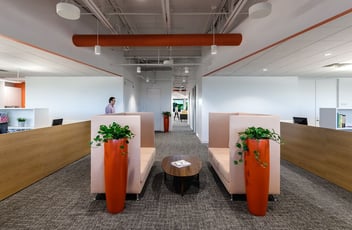
Sound masking is the strategic introduction of continuous, engineered background sound—often resembling gentle airflow—to reduce the perceived intelligibility of human speech. Implemented properly, a sound masking system improves speech privacy, minimizes noise distractions, and supports better workplace acoustics. In private offices, conference rooms, and waiting rooms, these benefits extend to enhanced comfort and productivity.
However, a question that often arises at trade shows and educational webinars is: "Does sound masking work without causing adverse health reactions such as headaches or nausea?" Let's explore the answer.
The history of sound masking
Sound masking solutions have been successfully deployed in commercial environments since the 1960s. Early systems, though less sophisticated than today's models, operated on the same basic principle: using specifically engineered speakers to distribute added sound throughout a space to cancel sound distractions.
Decades of implementation have shown no evidence that sound masking systems cause adverse health effects. On the contrary, sound masking work has consistently enhanced workplace acoustics without introducing extremely irritating or harmful elements to the human ear.
How sound masking systems operate
Modern systems like Cambridge Qt use pink noise—a balanced background sound centered around the frequency range of human speech—to effectively lower speech intelligibility. These systems create a quiet, comfortable environment that makes it difficult for conversations to be overheard at a distance.
Sound masking level (loudness)
Sound masking typically operates at a measured sound pressure level (SPL) of no more than 48 decibels A-weighted (dBA) in an open office. This sound masking level is significantly lower and set at 40 to 42 dBA in private offices. Such SPL levels are much lower than many common sounds, such as road noise when riding in an automobile or normal face-to-face conversation (which averages 65 dBA at three feet away). A-weighting is a filter process used to better represent sound levels based on how humans perceive sound and is the standard for the measure of environmental noise levels.

The Occupational Safety and Health Administration (OSHA) regulates safe occupational noise exposure levels in dBA SPL over time as published in Title 29 of the Code of Federal Regulations Part 1910.95. For an 8-hour period, the allowable continuous noise exposure is 90 dBA, while 80 dBA is permissible for a 32-hour period. The full details of this regulation are available here.
The decibel (dB) is an expression of a logarithmic relationship; therefore, 90 dBA represents an acoustic pressure exposure more than 125 times more powerful than the 48 dBA level of typical sound masking in an open office space. It is worth noting that sound masking solutions from Biamp are not capable of producing sound levels even approaching OSHA limits. The amplifier and loudspeaker assemblies are physically incapable of producing sufficient energy to pose a safety hazard.
Why sound masking solutions are safe
The speakers and amplifiers used in sound masking solutions are physically incapable of reaching harmful levels. Their purpose is to subtly enhance the environment, not to overwhelm it. Even when the system is heard directly under a ceiling emitter, it remains safe and non-disruptive.
ASTM International
ASTM International is a standards organization that provides test methodologies and guidelines for evaluating many different aspects of buildings and architecture. The ASTM E33 committee is comprised of acoustical consultants, manufacturers of acoustical products, and acoustical laboratories that recognize sound masking as a safe technology.
In 1970, ASTM formed a committee for building and environmental acoustics under the designation E33. The ASTM E33 committee is comprised of acoustical consultants, manufacturers of acoustical products, and acoustical laboratories. Since 1970, the E33 committee has produced hundreds of standards related to building acoustics, including four that reference sound masking as a safe and recommended technology:
ASTM E1374 – Standard Guide for Open Office Acoustics and Applicable ASTM Standards
ASTM E1573 – Standard Test Method for Evaluating Masking Sound in Open Offices Using A-Weighted and One-Third Octave Band Sound Pressure Levels
ASTM E1130 – Standard Test Method for Objective Measurement of Speech Privacy in Open Plan Offices Using Articulation Index
ASTM E2638 – Standard Test Method for Objective Measurement of Speech Privacy Provided by a Closed Room
The importance of proper installation
Like all other professional audiovisual technologies, sound masking requires installation and tuning by a properly trained system integrator. A sound masking system that isn’t installed correctly—with emitters (specially engineered loudspeakers) improperly spaced or wired out of sequence, and if there are two similar output channels next to each other—could create the comb-filtering effect.

If a person is sitting precisely in the middle of those two emitters, it could potentially create an uneasiness (some refer to this as a phasing issue). But this shouldn’t create any adverse effects, and the issue can easily be addressed by installing the emitters in their proper locations.
Even when properly installed and tuned, a sound masking system introduces a new acoustical element in any environment. This is why upon installation, the system should be programmed to gradually “ramp up” the volume at which it operates. This helps those within sound masking’s range to become acclimated to the new background sound without disruption.
The output should naturally blend in with any environment’s existing acoustics and be almost unnoticeable to those working where sound masking is present.
Conclusion
OSHA and ASTM are just two of the organizations that recognize sound masking as a viable, safe technology for reducing speech intelligibility and noise-related distractions, thereby improving acoustic privacy and workplace comfort and productivity. Sound masking also protects patient confidentiality and helps patients sleep better while being treated in medical facilities.
Editor's Note: This article is made in collaboration with IFMA's Corporate Sustaining Partner, Biamp. As the pioneer in sound masking solutions and the developer of the Qt X sound masking platform, Biamp is dedicated to the safety and efficacy of our products and their implementation. To that end, Biamp makes our highly educated and experienced acoustical/engineering staff available for further discussion and ensures that our partner installers are trained on best practices.














